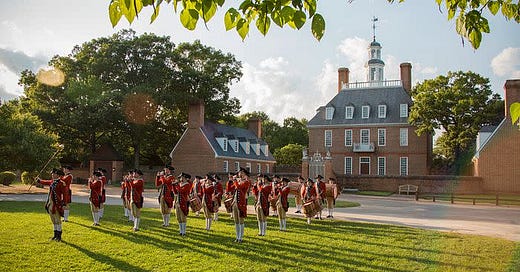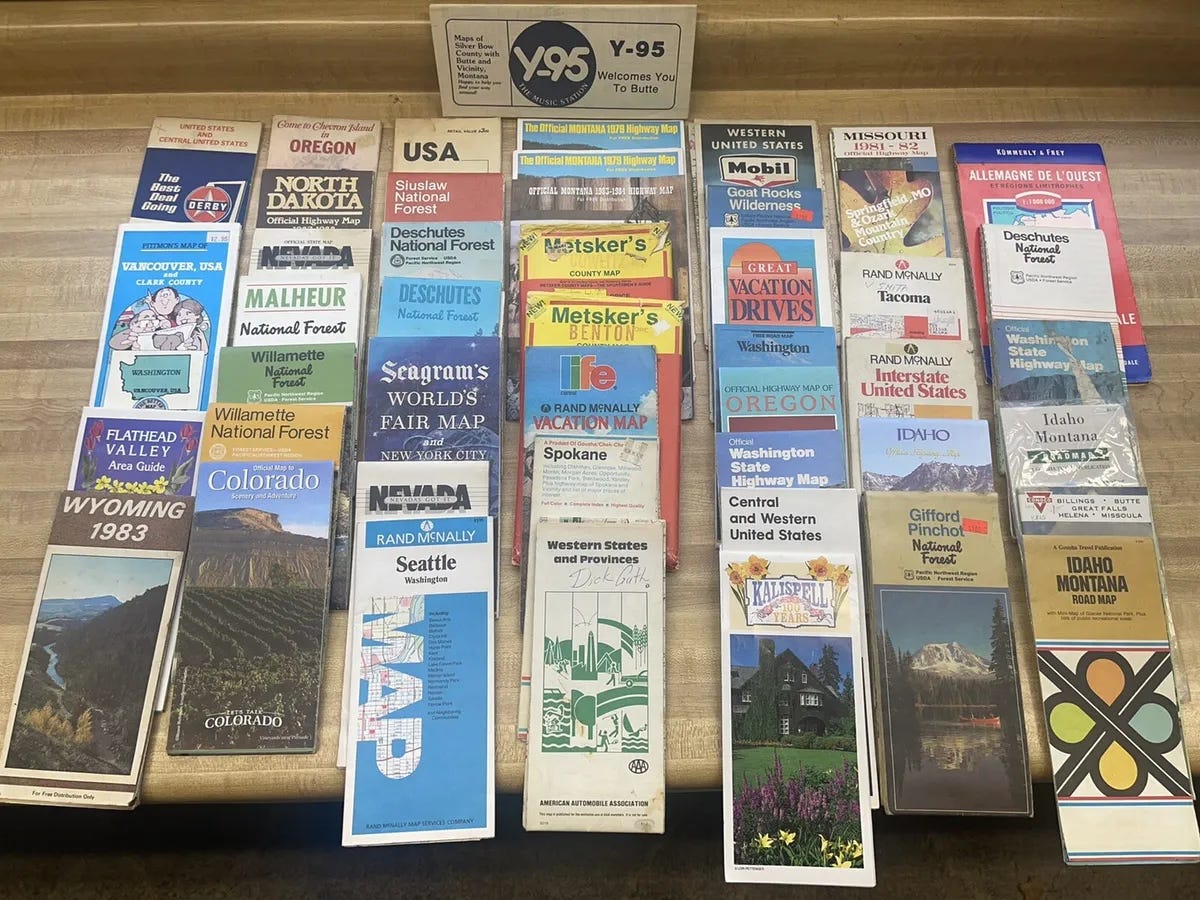My husband and I are embarking on a trip to Williamsburg, Virginia. It will be a working vacation for me, as I plan to teach my usual schedule of online English students from there and sprinkle my sightseeing around the edges, but I’ve been looking forward to it for months! We went to Williamsburg last spring and found ourselves wishing we had more time to spend there—particularly in the historic district, which is properly described as a living history museum.
I don’t yet have photos or stories to share from this autumn excursion, and next Tuesday I’ll be posting my end-of-the-month roundup for October on Substack, so I may share more about our Virginia trip in November, but I’ll post a YouTube video on down below that gives a sense of how historic Williamsburg has been restored to approximate what residents and visitors experienced in the late 1700s when Williamsburg was the capital of Virginia, first as a colony and then as an independent state from June of 1776 through 1779.
Williamsburg was the political, cultural, and educational center of what was the largest, most populous, and most influential of the original British colonies. In 1780, Governor Thomas Jefferson permanently moved the capital of the Commonwealth of Virginia farther inland to Richmond because Williamsburg was vulnerable to British attack. Virginia joined the Union—the United States of America—in 1788. The state capital remains in Richmond to this day.
Jefferson, who penned most of the Declaration of Independence before becoming Virginia’s governor at age 36, went on to become the new nation’s first Secretary of State under President George Washington, its second Vice President under President John Adams, and the third President of the United States in 1801.
As a young student, I confess that history was not a favorite subject for me. My brain didn’t seem to be wired for it--at least not the way it was taught in school. I struggled to remember names and dates, and when taking tests, I could often recall where an answer had been located in the textbook but not the answer itself. To my great frustration, I never received even partial credit for explaining that the requested information could be found at the beginning of the chapter, directly under the picture of Thomas Jefferson.
Had history been taught more like the scenes of the musical, Hamilton, I’d have warmed up to it sooner. I confess that today when I think of Thomas Jefferson, I immediately envision the brilliant Daveed Diggs.
I had similar struggles with geography. My 8th grade civics teacher had her classes go through an exercise designed to help us learn the locations of cities and towns in the state of Georgia. It proved to be a popular project with many students.
This was in the days before GPS, when (full-serve!) gas stations offered free paper fold-up road maps to customers. Ms. Ridgeway made arrangements to provide a large map of Georgia to each student and created a worksheet listing Georgia cities with a simple outline of the state of Georgia on an otherwise plain sheet of paper. We were to plot each of the listed cities within the outline she provided after looking up the locations on our maps.
Looking back, it was a great project! The classroom was abuzz with students searching for obscure cities and talking about places they had been to or where their relatives lived. Even students who were not usually engaged in class seemed to take a great interest in making their maps.
It’s my impression that inventive class projects are almost the norm in public education now, but in my childhood we spent the bulk of our classroom time in an all-too-familiar routine of starting with the assigned reading from a slightly outdated textbook, followed by a lecture, and finally we answered the questions at the end of the chapter. The test was on Friday, with a strong possibility of a pop quiz during the week.
Ms. Ridgeway’s map idea was fun and different for us, but it bothered me that I wasn’t good at it. It was hard to get the cities and towns properly situated on my little map. The bigger disappointment was that we didn’t receive any credit for those maps that we had worked so hard on in class. Rather, we were to take them home and study them for a test that would determine our grade for that unit.
You probably know what’s coming: For the test, we were provided a fresh blank outline of Georgia to fill with the cities on that long list, but no road map to go by. In spite of studying for the test, I was terrible at this task. I may have eventually put 6-8 decent-sized cities (out of at least 30) in approximately the right places. Beyond that, I had no reliable sense of where the various smaller towns were in relation to each other.
I’m still bad at this, by the way. No matter how many times I drive down I-75 into the state of Florida, for example, I can’t accurately predict the order of the sights and towns along the way.
Plenty of “C-students” proudly scored 100% on that Georgia Cities exam. Mercifully, I don’t remember my score, but it was nowhere near 100. This experience may have been the first time I considered the fact that straight-A students aren’t necessarily any “smarter” than the others. They are simply practiced at the particular skills that schools like to measure.
In that sense, the map project was a good lesson for me, but it didn’t make me any better at—or more interested in—geography.
Sadly, the overarching lesson of high school for me was to avoid classes I might not do well in. My goals gradually shifted from learning new things to strategically cultivating grades that might allow me to qualify for scholarships and get into good schools.
Even in college, the only social studies courses I took were the required ones. My dad told me that once I got older and did some traveling I would develop a greater love of history. I was certain he was mistaken.
Dad had toured Europe as soloist and concertmaster of the Seventh Army Symphony Orchestra, and it opened up a whole new world for him. He returned to the States with a newfound interest in foreign languages, history, philosophy, travel, and photography. But it seemed unlikely to me that anything in my life would prove similar to his experience.
It will come as no surprise to you that my dad was right. History is very much a beloved subject for me now. Although I never lived in Europe as my parents did during my father’s army years, I got a tiny taste of both Canada and parts of Europe from going on college choir tours, which I thoroughly enjoyed. What made the biggest difference for me, however, in learning to love history was being released from the tyranny of grades.
I’m a curious person by nature, so it was incredibly freeing after graduation to finally explore whatever topics interested me without worrying about the consequences. This was true of subjects even beyond history. One of my great joys after college was attending music conferences and workshops where I could learn—and explore—so much in a concentrated period of time without the first thought of grades.
When it comes to history and geography, I find I’m especially interested in what day-to-day life would have been like for people in earlier times and other places. How did they feel about their lives and the places they lived? What were their expectations? How did their experiences compare with ours today? Surely that’s why we classify subjects like these as Social Studies.
Still more essential are the lessons that we as a people need to learn from history. I’m listening to the audiobook of Rachel Maddow’s recently released, Prequel: An American Fight Against Fascism, in the car on the trip, and it’s loaded with vitally important examples.
Those that fail to learn from history are doomed to repeat it.
—Winston Churchill
My interest in the experiences of people from various times and cultures is one reason I enjoy tutoring English students from so many different countries. Chatting with students with a wide range of backgrounds has given me a window into the world that I’ve never had before. I love hearing what my students are thinking about each week. (And I don’t give grades.)
So it follows that one of the things I enjoy most about the Williamsburg experience is exploring what it might have been like to go to court in 1775 or visit an apothecary or dressmaker, or stay overnight in a tavern or survive The American Revolutionary War. It’s not the sort of thing textbooks get into, but it makes history come alive. As an English tutor, it’s also fun to discover the origins of modern idioms that have their roots in colonial times—and there are many.
I’m sure it will be a fascinating week for us! Have you been to Williamsburg? What are some of your favorite historic vacation destinations?
The video below is nearly 3 years old but offers a nice overview of the historic Williamsburg experience. The pandemic restrictions have since been lifted, so it’s more crowded now, but you can still get a sense of what it’s like to visit. I heard a historian in another video describe Colonial Williamsburg as “Disney World for historians.” I take her point, but it doesn’t exactly feel like a theme park. I find that historic Williamsburg makes me ponder not only what colonial life was like but how those experiences and events helped shape the lives we live today.







I’m sure you’ll enjoy peanut soup! It’s been a long time since my last visit but I too loved walking in the shoes of our past. Enjoy.
Here’s a link to my post about our trip. Spoiler Alert: We had a great time! https://open.substack.com/pub/lroseen/p/reflections-on-colonial-williamsburg?r=cxl3&utm_medium=ios&utm_campaign=post